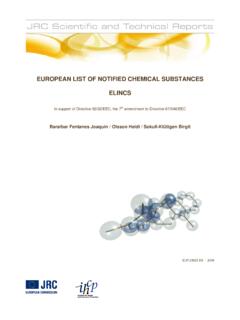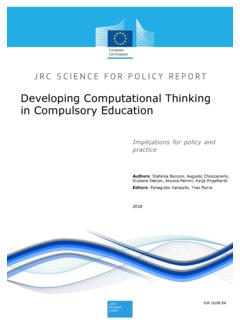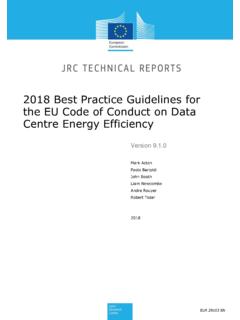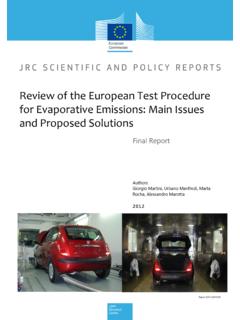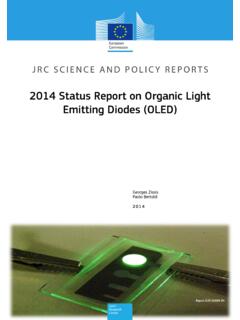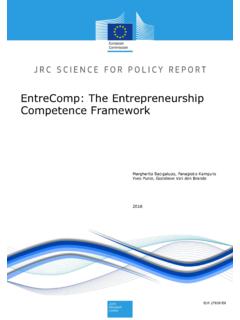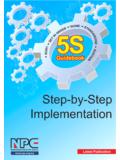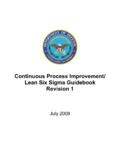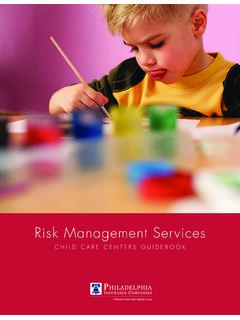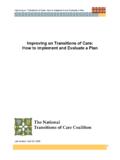Transcription of Guidebook 'How to develop a Sustainable Energy and Climate ...
1 Guidebook 'How to develop a Sustainable Energy and Climate Action Plan (SECAP)'. Part 1 - The SECAP. process, step -by- step towards low carbon and Climate resilient cities by 2030. Bertoldi, P. (editor). Full list of authors in the acknowledgements 2018. EUR 29412 EN. This publication is a Science for Policy report by the Joint Research Centre (JRC), the European Commission's science and knowledge service. It aims to provide evidence-based scientific support to the European policymaking process. The scientific output expressed does not imply a policy position of the European Commission.
2 Neither the European Commission nor any person acting on behalf of the Commission is responsible for the use that might be made of this publication. Contact information Name: Paolo Bertoldi (Editor). Address: European Commission, Joint Research Centre, Via Enrico Fermi 2749 - 21027 Ispra (VA), Italy Email: Tel.: +39 0332789299. EU Science Hub JRC112986. EUR 29412 EN. PDF ISBN 978-92-79-96847-1 ISSN 1831-9424 Print ISBN 978-92-79-96848-8 ISSN 1018-5593 Luxembourg: Publications Office of the European Union, 2018. European Union, 2018. The reuse policy of the European Commission is implemented by Commission Decision 2011/833/EU of 12.
3 December 2011 on the reuse of Commission documents (OJ L 330, , p. 39). Reuse is authorised, provided the source of the document is acknowledged and its original meaning or message is not distorted. The European Commission shall not be liable for any consequence stemming from the reuse. For any use or reproduction of photos or other material that is not owned by the EU, permission must be sought directly from the copyright holders. All content European Union 2018. How to cite this report: Bertoldi P. (editor), Guidebook 'How to develop a Sustainable Energy and Climate Action Plan (SECAP) Part 1 - The SECAP process, step -by- step towards low carbon and Climate resilient cities by 2030, EUR 29412 EN, Publications Office of the European Union, Luxembourg, 2018, ISBN 978-92-79- 96847-1, , JRC112986.
4 Contents Abstract .. 1. Acknowledgements .. 2. Executive summary .. 3. 1 Introduction .. 6. Policy context .. 6. About the Covenant of Mayors for Climate and Energy in Europe .. 7. About the Global Covenant of Mayors .. 10. About this Guidebook .. 11. 2 The Sustainable Energy and Climate Action Plan a way to go beyond the European Union targets .. 13. Scope of the SECAP .. 13. Time horizon .. 14. The SECAP process .. 16. Human and financial resources .. 18. Joint SECAPs .. 18. SECAP document, template and submission procedure .. 19. Recommended SECAP structure.
5 21. Key elements of a successful SECAP .. 24. Ten key elements to keep in mind when preparing a SECAP .. 25. 3 Political commitment .. 29. 4 Mobilization of all municipal departments involved () .. 31. How to adjust administrative structures .. 31. Examples from Covenant signatories .. 33. External support: Covenant Territorial Coordinators and Local and Regional Energy 34. 5 Building support from stakeholders .. 37. Who are stakeholders? .. 37. How to engage in stakeholder participation .. 41. Communication .. 44. 6 Assessment of the current framework: where are we?
6 46. Analysis of relevant regulations .. 46. Baseline review: Baseline Emission Inventory and Climate Change Risk and Vulnerability Assessment .. 46. Baseline Emission Inventory (BEI) .. 46. Risk and Vulnerability Assessment .. 47. SWOT analysis .. 48. 7 Establishment of a long-term vision with clear 50. i The vision: towards a Sustainable future .. 50. Setting objectives and targets .. 52. 8 SECAP elaboration .. 54. 9 SECAP implementation .. 58. 10 Monitoring and reporting progress .. 59. 11 Conclusions .. 61. Annex 1. Example of aspects suggested to be covered in the baseline mitigation reviews 62.
7 Annex 2. Benefits of SECAP .. 65. Annex 3. Glossary .. 66. List of abbreviations and definitions .. 71. List of Boxes .. 72. List of Figures .. 73. List of Tables .. 74. ii Abstract The Covenant of Mayors for Climate and Energy (CoM) is an ambitious initiative for local Climate and Energy actions. This document provides signatories with a set of methodological principle, procedures and best practices to develop their SECAP. The Part 1 of this document relates to the SECAP process; while Part 2 gives an insight on the elaboration of municipality assessments (BEI and RVA), finally Part 3 describes technical issues, measures and policies that can be implemented at local level.
8 1. Acknowledgements The authors would like to thank the European Commission Directorate-General for Energy (DG ENER), colleagues Eero Ailio, Sebastien Occhipenti, John Stuebler, Joanna Ziecina; the European Commission Directorate-General for Climate Action (DG CLIMA), colleagues Sandro Nieto Silleras, Dina Silina, Christopher Ahlgren Anders, Alessandra Sgobbi, for their work and support in giving visibility and effectiveness to the efforts of cities and local authorities in the CoM initiative. Special thanks to the European Commission's Joint Research Centre's colleagues including Laura Rappucci for the editing.
9 Relevant contribution on reviewing this Guidebook have also been received from the Covenant of Mayors Office (CoMO), colleagues including Lucie Blondel, Alessandra Antonini, Giustino Piccolo, Lea Kleinenkuhnen, Fr d ric Boyer, Miguel Morcillo, and experts form municipalities, regions, agencies and private companies. Special thanks to local authorities who make public their engagement in Climate action planning through their participation in the Covenant of Mayors. Authors Rivas Silvia, Melica Giulia, Palermo Valentina, Dallemand Jean-Fran ois (JRC).
10 2. Executive summary The Covenant of Mayors for Climate and Energy (CoM) is the mainstream European voluntary movement involving local authorities in the development and implementation of Sustainable Energy and Climate policies. Policy context The European Union is leading the global fight against Climate change, and has made it one of its top priorities. Local authorities have a key role in the Climate change challenge. Over half of greenhouse gas emissions are created in and by cities. 80% of the population lives and works in cities, where up to 80% of Energy is consumed.
